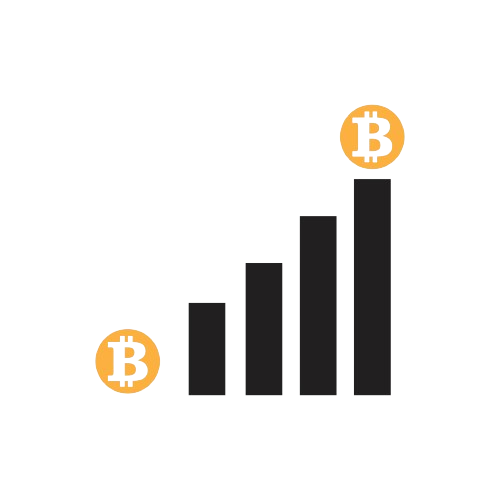
As we enter 2024, the cryptocurrency market stands at a critical juncture. Bitcoin has firmly established itself as an asset class and key macroeconomic developments in 2023 will shape price action this year. By analyzing expert predictions, on-chain trends, and global financial factors, traders can craft robust strategies to profit in Bitcoin’s markets in 2024. This comprehensive guide provides an outlook of what’s ahead and how to strategically trade the anticipated volatility.
As bitcoin continues its volatile price journey into 2024, investors try gauging where the cryptocurrency could be headed next. Making accurate Bitcoin price predictions depends greatly on properly assessing and strategizing around key market factors impacting its future trajectory. This guide explores essential considerations for structuring Bitcoin investment game plans amidst the current macroeconomic climate.
Understand Bitcoin’s Value Drivers
Before exploring market variables shaping bitcoin’s outlook, revisiting core aspects underlying bitcoin’s fundamental value provides helpful context:
Scarcity
The Bitcoin algorithm caps supply at 21 million units, with roughly 19 million currently in circulation. This fixed scarcity contrasts with fiat currencies subject to potentially unlimited printing that erodes purchasing power over time. The aspirational store of value case stems from faith in cryptography to enforce this verifiable scarcity not subject to human interference. However, critics argue computational breakthroughs could undermine this faith even if not currently foreseeable
Decentralization
Bitcoin’s permissionless blockchain enables direct peer-to-peer transactions without centralized intermediaries. Supporters cite this as revolutionary for money transmission and counterparty trust dependencies involving banks or payment networks. However decentralized structure introduces tradeoffs around efficiency, costs and complexity relative to intermediary roles. Ongoing scaling efforts aim to ease these decentralization growing pains.
Transparency

Bitcoin’s public blockchain fully exposes every transaction ever completed. While enabling auditability and transparency, some critique this financial openness relative to privacy coins or traditional anonymity. Regardless of ideological perspectives, understanding Bitcoin’s transparent nature matters for practical considerations and regulation.
Assess Market Cycles and Macroeconomics
Zooming out beyond purely protocol-level features, bitcoin exists within broader economic contexts impacting investment appetites across financial markets.
Market Psychology and Investor Sentiment
Despite aspirational narratives about Bitcoin’s future, current prices remain highly sentiment-driven by momentum and speculation. After peaking near $69,000 in late 2021, subsequent fear, uncertainty and doubt crashed prices over 60% by mid-2022. Both rallies and declines often overshoot logical extremes due to collective investor psychology vulnerable to panic and exuberance.
Macroeconomic Conditions
High inflation facing many developed economies simultaneously prompts disagreement on the impacts of Bitcoin as a speculative asset versus a potential inflation hedge. Some compare the stagflationary 1970s outperformance of gold to argue similar prospects for Bitcoin. However, others caution Bitcoin remains highly correlated to tech stocks vulnerable to rising rates and recessionary threats. Ongoing debates will likely intensify around these economic themes.
Regulatory Developments
Evolving government oversight also influences Bitcoin investing options and risks. Changeable political stances range from China’s rigid 2021 crypto crackdown to Brazil’s recently proposed bitcoin adoption legislation. In the US, the focus centers on clear regulatory guardrails without outright bans. Determining jurisdictional alignments helps inform geographic investment allocation decisions.
Factor Geopolitical Considerations
On a more episodic basis, global events like military conflicts, trade wars, or energy market disruptions occasionally cascade into financial markets. For instance, Russia’s invasion of Ukraine sparked asset sell-offs and magnified inflation. Bitcoin largely moved in concert with such broad risk-off sentiments. Tracking geopolitical developments is prudent for anticipating potential volatility triggers despite the lack of direct ties to cryptocurrency.
Evaluate On-Chain Analytics
Beyond external variables, assessing activity directly within Bitcoin’s blockchain offers supplemental perspectives on positioning among different investor cohorts:
Exchange Flows
Monitoring the volume of bitcoin transfers on/off exchanges signals bull/bear expectations. Periods of heavy inflows to exchanges typically foreshadow increased selling pressure as investors convert holdings to fiat. By contrast, bitcoin accumulation withdrawing from exchanges reduces available supply and signals longer-term holding convictions.
Active Addresses
The tally of active network addresses particularly those transacting frequently or after long dormancy can indicate a reawakening of investor interest. After severe bear markets, renewed activity points to early signs of changing momentum. Distinguishing between short-term speculators versus holders storing Bitcoin securely in “cold storage” also provides valuable adoption insights.
Develop an Investment Strategy

With robust perspectives on price drivers and market factors, investors can structure strategic plans aligned with personal risk tolerances and Bitcoin outlooks.
Dollar Cost Averaging
Given bitcoin’s propensity for volatility, dollar cost averaging offers a more controlled entry point by incremental buying to smooth out pricing exposure rather than large lumpsum purchases. Investors essentially hedge against timing predictions.
Portfolio Allocations
As with traditional assets, bitcoin investing should involve appropriate portfolio weightings rather than disproportionate “all-in” overtures. Conservatively capping allocations helps manage risk as understanding evolves. Of note, bitcoin stored in a secured personal or institutional Bitcoin wallet avoids potential trading temptations.
Investment Horizons
Consider if short-term trading opportunities or long-term holdings make sense for your strategy depending on conviction forecasts. Shorter-term perspectives warrant more active risk management. Meanwhile, “HODLing” supports network security akin to early internet infrastructure development powered by committed, patient users equivalent to today’s ISPs.
Optional Strategies
Beyond basic buying and holding, options contracts, bitcoin futures, and yield harvesting approaches offer additional strategic avenues depending on risk appetite. However, like any complex investment product, ensure thorough diligence around risks.
Rethink Strategy Dynamically
As with any freewheeling market, successful Bitcoin strategies require ongoing reevaluation as key factors evolve to determine reasonable forecast revisions and responsive tactics for preserving performance.
Conclusion
Mastering bitcoin investment requires grappling with volatility surpassing traditional asset categories. By judiciously evaluating price drivers, market conditions, global impacts and blockchain activity, investors assemble strategic perspectives for tuning approaches over time. Bitcoin’s long-term trajectory relies on broadening understanding and adoption amidst regulatory advancements. With thoughtful analysis and prudent risk-taking fully appreciating Bitcoin’s embedded principles and acceptance challenges, investors chart courses aligning strategy with their vision for this epochal financial innovation.